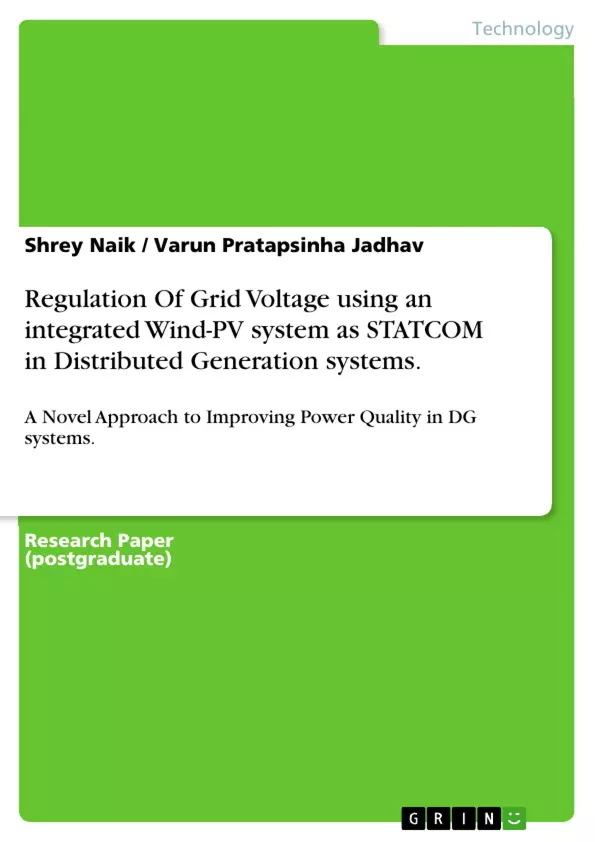In the proposed paper, it is described how a Solar PV Farm along with a battery storage system can be used to regulate grid voltage in a PV-Wind integrated distributed generation System.
At night time Solar PV system is normally dormant (i.e. it does not generate power) but the stored power in batteries can be utilised efficiently to regulate the common coupling voltage by means of a FACTS based Static Synchronous Compensator (STATCOM) thereby improving the power quality.
Various Utilities are facing major issues with Grid Integration of various types of Renewable Energy Distributed Systems while ensuring power quality ,Regulation and Stability. During day time the inverter of PV system provides the power to Grid but during night time PV farm is inactive and stored energy in the batteries can be used as power source to PV inverter for implementing a STATCOM.
with advancements in RES and increasing DG systems to provide for load demand the quality of power has to be maintained to optimum value and this paper focuses purely on improving regulation of voltage without using external regulation devices but the installed RES system.
In order to implement and validate the concept of the prescribed paper SIMULINK Tool has been used.
Inhaltsverzeichnis (Table of Contents)
- I. INTRODUCTION
- II. DG SYSTEM OVERVIEW
- III. SOLAR PV FARM AS A BATTERY CHARGER
- IV. DOUBLE FED INDUCTION GENERATOR
- V. STATCOM
- VI. CONTROL SCHEME FOR PV INVERTER
- VII. SIMULATION RESULTS
- VIII. CONCLUSION
Zielsetzung und Themenschwerpunkte (Objectives and Key Themes)
This paper investigates the integration of a solar PV farm with a battery storage system to regulate grid voltage in a distributed generation system. The primary goal is to demonstrate the feasibility of using an existing PV farm inverter as a STATCOM during nighttime to mitigate voltage fluctuations caused by wind farm power generation and load variations.
- Integration of renewable energy sources (wind and solar) in distributed generation systems
- Voltage regulation in power grids using STATCOM technology
- Utilization of PV farm inverters as STATCOMs for nighttime voltage control
- Battery storage integration for real power exchange and voltage regulation
- Simulation studies using MATLAB/SIMULINK to validate the proposed approach
Zusammenfassung der Kapitel (Chapter Summaries)
- I. INTRODUCTION: This chapter introduces the challenges of integrating large-scale renewable energy systems into existing power grids, particularly in the context of voltage regulation and power quality. It highlights the need for efficient voltage control solutions, especially during nighttime when solar PV farms are inactive.
- II. DG SYSTEM OVERVIEW: This chapter provides a brief overview of the integrated wind energy and PV system with battery storage. It outlines the system components, including the wind farm, PV farm, and battery storage, and their respective functionalities.
- III. SOLAR PV FARM AS A BATTERY CHARGER: This chapter explains how a PV solar farm can be utilized as a battery charger during nighttime. It describes the operational modes of the solar farm and the role of the bidirectional inverter in charging the battery from the main grid.
- IV. DOUBLE FED INDUCTION GENERATOR: This chapter delves into the principle of operation of a Double Fed Induction Generator (DFIG), commonly used in wind turbines. It discusses the advantages and disadvantages of DFIGs and their control strategies.
- V. STATCOM: This chapter introduces the concept of a Static Synchronous Compensator (STATCOM) and its role in improving the voltage profile of a power system. It highlights the advantages of STATCOMs over other voltage regulating devices.
- VI. CONTROL SCHEME FOR PV INVERTER: This chapter describes the control scheme used to regulate the PCC voltage using the PV inverter as a STATCOM. It outlines the control loops, PLL-based synchronization, and hysteresis current controller.
- VII. SIMULATION RESULTS: This chapter presents the simulation results obtained using MATLAB/SIMULINK to validate the proposed concept. It discusses the performance of the system under normal conditions and during fault scenarios, demonstrating the effectiveness of the STATCOM in regulating voltage.
Schlüsselwörter (Keywords)
The key focus areas of this paper are grid voltage regulation, distributed generation, renewable energy integration, STATCOM, PV farm, wind farm, battery storage, and simulation studies using MATLAB/SIMULINK. The work explores the potential of utilizing existing PV farm infrastructure for voltage control and facilitates the integration of more renewable energy sources into the grid.
- Quote paper
- Shrey Naik (Author), Varun Pratapsinha Jadhav (Author), 2014, Regulation Of Grid Voltage using an integrated Wind-PV system as STATCOM in Distributed Generation systems., Munich, GRIN Verlag, https://www.grin.com/document/283560



